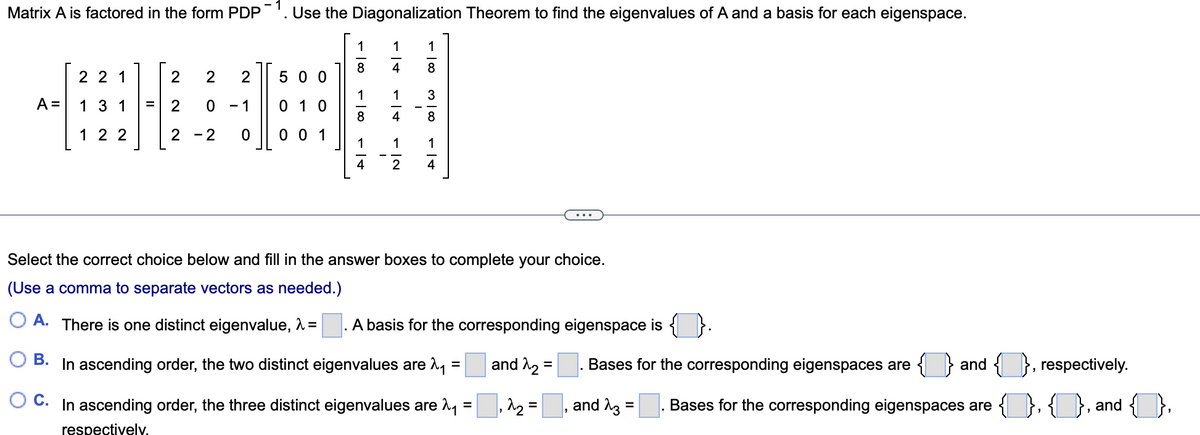Matrix A is factored in the form PDP . Use the Diagonalization Theorem to find the eigenvalues of A and a basis for each eigenspace. 1 8 4 8 2 2 1 2 2 5 0 0 3 A = 1 3 1 = 2 0 - 1 0 1 0 8 4 1 2 2 2 -2 0 0 1 1 1 4 4. Select the correct choice below and fill in the answer boxes to complete your choice. (Use a comma to separate vectors as needed.) O A. There is one distinct eigenvalue, 1 = A basis for the corresponding eigenspace is { }. O B. In ascending order, the two distinct eigenvalues are , = and 2 = Bases for the corresponding eigenspaces are and {}. O C. In ascending order, the three distinct eigenyalues are M = and λ Bases for the corresponding eigenspaces are
Matrix A is factored in the form PDP . Use the Diagonalization Theorem to find the eigenvalues of A and a basis for each eigenspace. 1 8 4 8 2 2 1 2 2 5 0 0 3 A = 1 3 1 = 2 0 - 1 0 1 0 8 4 1 2 2 2 -2 0 0 1 1 1 4 4. Select the correct choice below and fill in the answer boxes to complete your choice. (Use a comma to separate vectors as needed.) O A. There is one distinct eigenvalue, 1 = A basis for the corresponding eigenspace is { }. O B. In ascending order, the two distinct eigenvalues are , = and 2 = Bases for the corresponding eigenspaces are and {}. O C. In ascending order, the three distinct eigenyalues are M = and λ Bases for the corresponding eigenspaces are
Linear Algebra: A Modern Introduction
4th Edition
ISBN:9781285463247
Author:David Poole
Publisher:David Poole
Chapter4: Eigenvalues And Eigenvectors
Section4.3: Eigenvalues And Eigenvectors Of N X N Matrices
Problem 24EQ
Related questions
Question

Transcribed Image Text:Matrix A is factored in the form PDP
Use the Diagonalization Theorem to find the eigenvalues of A and a basis for each eigenspace.
1
1
1
8
5 0 0
4
8
2 2 1
2
2
1
1
3
A =
1 3 1
2
- 1
0 1 0
8
4
8
1 2 2
2
0 0 1
1
1
1
4
2
4
Select the correct choice below and fill in the answer boxes to complete your choice.
(Use a comma to separate vectors as needed.)
O A. There is one distinct eigenvalue, =
|. A basis for the corresponding eigenspace is { }.
B. In ascending order, the two distinct eigenvalues are ^1
and 2 = . Bases for the corresponding eigenspaces are
{
and { }, respectively.
%3D
O C. In ascending order, the three distinct eigenvalues are 4 =, ^2 =, and 13
Bases for the corresponding eigenspaces are
{);{), and {}.
respectivelv.
Expert Solution
This question has been solved!
Explore an expertly crafted, step-by-step solution for a thorough understanding of key concepts.
Step by step
Solved in 4 steps with 4 images

Recommended textbooks for you

Linear Algebra: A Modern Introduction
Algebra
ISBN:
9781285463247
Author:
David Poole
Publisher:
Cengage Learning

Elementary Linear Algebra (MindTap Course List)
Algebra
ISBN:
9781305658004
Author:
Ron Larson
Publisher:
Cengage Learning

Algebra & Trigonometry with Analytic Geometry
Algebra
ISBN:
9781133382119
Author:
Swokowski
Publisher:
Cengage

Linear Algebra: A Modern Introduction
Algebra
ISBN:
9781285463247
Author:
David Poole
Publisher:
Cengage Learning

Elementary Linear Algebra (MindTap Course List)
Algebra
ISBN:
9781305658004
Author:
Ron Larson
Publisher:
Cengage Learning

Algebra & Trigonometry with Analytic Geometry
Algebra
ISBN:
9781133382119
Author:
Swokowski
Publisher:
Cengage